Electronics Show 2001
Electronics Show 2001
Student projects in the Physics department’s Electronics course were all on display in a grand show Dec 7, 2001. Over 100 visitors came to see the clever gadgetry on display.
- Balancing Act
Matt Schrock
Reuben Budiardja - Chaotic Bender Bouncer
Matt Fisher
Matt Rissler - Guitar Distortion Box
Luke Jordan - Mouse Interpreter
David Unzicker
Arthur Christoph - Reflex Timer
Jennifer Springer
Aaron Lehman - Remote Labyrinth Controller
Matt Eash - Whistle for Service
Jake Rigsby
Reuven Hodges - Wireless Anti-intrusion Device (WAD)
James Hiebert
Eric Kanagy
Whistle for Service
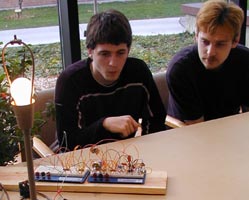
Reuven Hodges
Jake Rigsby
Reuven is whistling the correct pitch to toggle the lamp on or off.
A microphone and amplifier feed a bandpass filter that picks out the whistle tone. A second filter senses other noise and inhibits operation if there is too much. Logic gates to do the decision making and toggling are connected to a solid state relay to switch the AC power on and off.
Wireless Anti-intrusion Device (WAD)
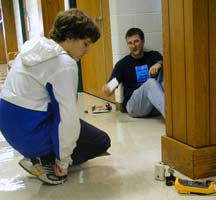
James Hiebert
Eric Kanagy
Eric (right) is about to block the laser beam so the WAD will send a special signal on the FM transmitter.
Unit 1 has an IR motion sensor connected to a laser diode. Motion near it will turn off the beam. Unit 2 has aphotodetector to sense if the beam is turned off or if it is blocked. Either causes a tone to be sent on the FM transmitter. A second IR sensor in unit two causes a different tone to be sent. Any FM radio can be used to receive the intrusion warning signals.
Balancing Act
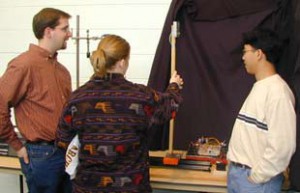
Matt Schrock
Reuben Budiardja
Matt (left) and Reuben watch as a visitor tests whether the stick can stay balanced when given a nudge.
A tall stick stands on a knife edge on a car. Their circuit uses an ultrasonic position sensor to send out a chirp 150 times per second directed at the top of the stick. The time delay of the echo is changed into a voltage representing the stick’s position. A differentiator finds the velocity of the stick. With appropriate gain, the position and velocity signals are added together and used to control an RC servomotor which moves the car to keep the stick balanced.
Guitar Distortion Box
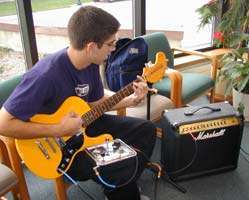
Luke Jordan
Luke plays his electric guitar through his distortion box (resting on his knee).
Several types of clipping can be switched in or out to give that fuzzy distortion that hard rockers love. An adjustable bandpass filter can further change the tone in interesting ways.
Remote Labyrinth Controller
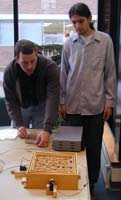
Matt Eash
Matt (right) watches while Biology professor tries to guide the ball through the labyrinth (foreground) by remote control.
RC servomotors are used to control the knobs of the labyrinth. They are designed to receive a pulse width modulated signal. Matt’s circuit takes a voltage input from a potentiometer and creates a pulse train in which the pulse width varies according to the input voltage.
Mouse Interpreter
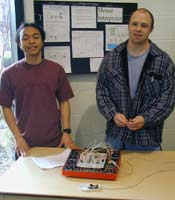
David Unzicker
Arthur Christoph
David (right) and Arthur designed a circuit to speak to and understand a PS/2 mouse without a computer or microprocessor.
Using simple digital logic their circuit is able to send the mouse any serial command in the PS/2 protocol. After the correct commands, the mouse then responds with packets telling about its movement and buttons all of which can be seen on an oscilloscope. The second part of the circuit to interpret and convert this data stream is yet to be built.
Reflex Timer
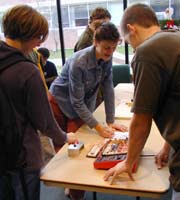
Jennifer Springer
Aaron Lehman
Aaron (right) explains to a visitor with her hand on the button that she must press it as soon as she sees the light come on. Jennifer is recording the reaction times.
When the tester presses the start button the circuit clears the LED displays and inititiates the random pulse generator. After a (psuedo) random time the light turns on and the counters begin counting the milliseconds. When the subject reacts and presses the stop button, the count freezes to show that person’s reaction time.
Chaotic Bender Bouncer
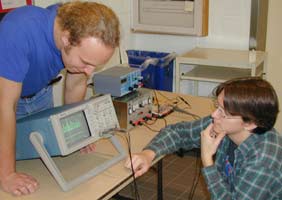
Matt Fisher
Matt Rissler
Matt (right) ponders the chaotic output on the oscilloscope while Matt (left) looks on.
The circuit is an exact analogue of a mechanical system called a Bender Bouncer which is a mass on a spring with damping and a barrier off which it bounces. By driving the system with a periodic force at the right frequency it can be made to bounce in a way mathematicians call “chaotic”. The motion of the mass is represented by a voltage which is plotted on the digital oscilloscope.




